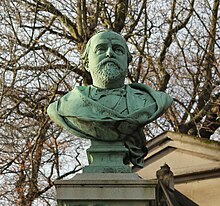Grands Magasins Dufayel
The Grands Magasins Dufayel was a large Parisian department store founded by Jacques François Crespin in 1856 and which lasted until the 1930s. The building is located at 22-34 rue de Clignancourt in the 18th arrondissement of Paris. The nearest metro station is Château Rouge on line 4 .
Jacques François Crespin

Jacques François Crespin (1824–1888) came from a farming family from Vidouville in the Manche department . When he married Pétronille Victorine Hannus in 1857, he named his profession a silver maker . Both founded a company in 1856 that sold goods of all kinds, especially furnishings, bedding, clothing, and jewelry on credit and took down payments on future purchases.
Between 1869 and 1887, Crespin and his wife bought numerous buildings between Boulevard Barbès (formerly Boulevard Ornano), Rue Christiani, Rue de Clignancourt and Rue de Sofia (formerly Rue de la Nation). They acquired a site of over 10,000 square meters on which they built a department store. The first buildings were completed in 1872 and 1874 and expanded two years later. The entire building complex formed a closed rectangle, the upper floors of which were rented. The ground floor and mezzanine were reserved for the department store. In the inner courtyard there were elongated halls with glass roofs that rested on iron girders and in which furniture was exhibited. An aviary and an aquarium were housed in one hall . The buildings on Rue de la Nation were partially demolished in 1883 and horse stables and coach houses were built. The construction work was led by the architects Alfred Le Bègue (1808–1881) and his son Stéphan (1844–1934). The sculptor Étienne Leroux created the decor with caryatids and atlases with which the sales room was equipped.
Crespin registered several patents for his inventions ( pleating machines, devices for heating irons, etc.). Over the years, he acquired 50 properties in Paris. He owned a country house in Nogent-sur-Marne and a castle in Pontault-Combault .
To attract and retain customers, they received a Paris travel guide ( Guide Conty ) as a gift . Crespin introduced the Bons Crespins , vouchers that could be redeemed in 300 shops.
Georges Dufayel
After the death of Jacques François Crespin, Georges Dufayel (1855–1916), who joined the company in 1871, continued the Grands Magasins Crespin-Dufayel . In 1892 the construction work started under Jacques François Crespin was completed. The hall of the inner courtyard, which was adjoined by two side halls, was almost 58 meters long, 13.60 meters high and 14 meters wide. All were covered with glass roofs. The rooms were heated with the Calorifère heating, which was new at the time, and illuminated with 2900 incandescent lamps and 140 arc lamps, for which the electricity was generated in an outbuilding.
From 1892, under the architect Gustave Rives (1858–1926), further buildings were built. He created the main entrance on Rue de Clignancourt, which is crowned by a gable with a relief by Jules Dalou ( progress guides trade and industry under the watchful eye of science and art ). The original dome with a lighthouse above the entrance is no longer preserved. For the interior decoration, the paintings, sculptures and ceramic paneling, artists were commissioned who were in fashion at the time, such as Luc-Olivier Merson and François Lafon .
In the furniture department, complete furnishings from all eras, from Gothic to contemporary style, were presented and famous rooms were reproduced, such as the bedroom of Louis XIV. The department store had a ballroom with a ceiling, the entire area of 500 square meters with ornate glazing . An orchestra played in a palm garden, there were film screenings and there was a theater with 350 seats. Two railway tunnels connected the buildings with a train station, which was in an annex. The horse stables and coach houses for the carriages with which the goods were delivered were housed in outbuildings.
In 1912 the Grands Magasins Crespin-Dufayel had over 15,000 employees and were considered one of the most important department stores in the world. In the 1930s, the Palais de la Nouveauté , as the department store was later called, was closed.
Todays use
After the Second World War, BNP set up its central administration in the former department store and employed 6,000 people there. In 1990 only 1,000 BNP employees worked there. In the following years the building was rebuilt and 280 apartments were furnished. Offices are located in one part of the building. Only the facades were preserved.
literature
- Bruno Centorame: Les Grands Magasins Crespin-Dufayel . In: Cathédrales du Commerce parisien. Grands Magasins et enseignes . Action Artistique de la Ville de Paris (Collection Paris et son Patrimoine), Paris 2006, ISBN 2-913246-57-5 , pp. 81-84.
- Jean Colson, Marie-Christine Lauroa (ed.): Dictionnaire des Monuments de Paris . Éditions Hervas, Paris 2003 (1st edition 1992), ISBN 2-84334-001-2 , p. 185.
Web links
- Grands Magasins Dufayel in Structurae (French)
Coordinates: 48 ° 53 ′ 5 ″ N , 2 ° 20 ′ 57 ″ E


